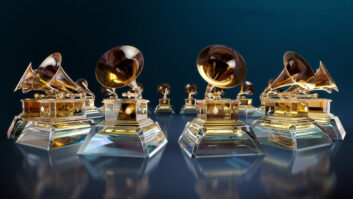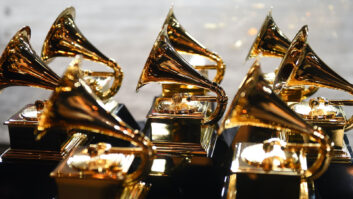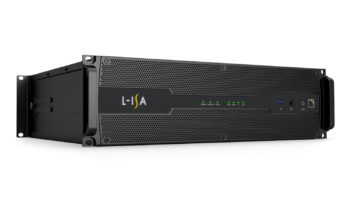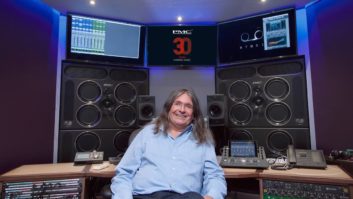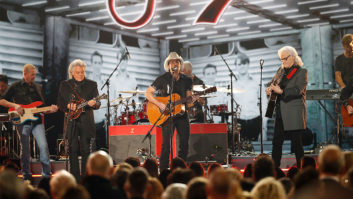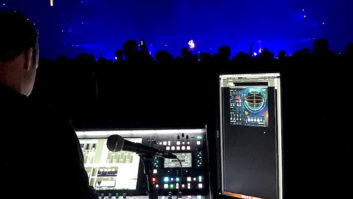NBC BUILDS PIPELINE FOR Olympics AudioWhile it’s true that the Olympics occur every two years, don’t tell that to NBC’s Philip Paully. As director of graphics engineering and operations at the network, he knows that working on that biennial sports extravaganza is a year-round, full-time job.
“We get back from Sydney with equipment at the end of November, and then we have under 13 months to go before we do Salt Lake,” says Paully, referring to the upcoming games in Australia (scheduled for Sept. 15-Oct. 1, 2000), and the 2002 winter contest set for Utah. “We have a month and a half off. From a planning perspective, we’re already on Salt Lake. We’re way past Sydney.”
And with an Olympics contract that extends until 2006, Paully is already thinking Athens and Milan, which will host the 2004 and 2006 Games, respectively. But from now until the aftermath of the 2000 Olympics, he is entrenched in Sydney.
To carry off the Herculean task of beaming the games to tens of millions of viewers – and listeners – in the U.S., NBC has built a state-of-the-art International Broadcast Center with an impressive array of audio recording, mixing, post-production and routing equipment.
“When we build this IBC, we’re one of the biggest facilities in the world for a two-week period,” says Paully. “And we’re not alone – every other country is in the space around us, sending this thing out to close to 3 billion people around the world. Everything comes into the IBC live, we pull it together and retransmit it from there.”
The IBC consists of two control rooms, A and B; a pair of small editing suites, C1 and C2; and an audio-production room positioned between C1 and C2. The remote audio and video recording devices at the various Olympic venues feed each of these studios. Sound signals from the field are gathered in a Yamaha 02R digital console at the IBC and distributed to the appropriate audio mixing or post-production systems on site. These include Calrec boards in Control Rooms A and B, Zaxcom Aria consoles in C1 and C2 and a new Fairlight FAME system in the audio-production room, which also contains an isolation booth used for last-minute voice-overs. A fiber optic network links all the systems, allowing audio and video operators to perform nonlinear edits to virtually any material and then send it on to the final broadcast destination.
The networking aspects of NBC’s production system are not only critical to the workflow at the Olympic venue, but they also allow operators back at headquarters to control machines located on-site. Such was the case in the 1996 Games, where playback devices in Atlanta were controlled from the New York facility.
While the technical and creative standards for all broadcast audio have increased over the years, audio for graphics has evolved at a particularly dramatic pace, according to Paully. “Audio plays more of a part in graphics in the last couple of years than it ever has,” he says. “I mean, it’s always played a part, but I remember at the 1996 Olympics in Atlanta, someone said to me, `This is graphics, there’s no audio in graphics.’ But there was a tremendous amount of audio, and there’s even more this time around. Most of our segments, shorts and everything else have to have audio and music.”
Paully adds that NBC has transcended the cheesy sound effects used on many sports broadcasts nowadays. “It’s more than just the male-oriented, special effect of a piece of gear getting hit fast, like a whoosh sound with a puck,” he explains. “It’s more than that. I doubt you would see a golf ball in our NBC Sports coverage turn red and go whoosh as Tiger hits it toward the hole. Our graphics are there to convey information about the events themselves, as opposed to highlighting things for shock value.”
From a technical standpoint, handling the multitude of digital audio and video formats that are used in broadcast is a monumental undertaking, but one that NBC has honed to a fine art.”We never met a format we didn’t like,” quips Paully. “We have audio on Digicarts, DATs, DA-88s, hard disks, etc., and we back up to CD, Exabyte or whatever else we need. Most of the audio is 24 bits, and it’s all routed digitally through AES/EBU connections at 48 kHz. In fact, we’ve had our Denon CD players modified to output 48 kHz.”
Computer file formats have also multiplied in recent years, and NBC needs to have a grip on all of them in order to meet its storage criteria, as well as its Internet needs. (“Any audio that’s going to get in, there’s going to be one program that’s going to read it and translate it to any other program,” says Paully.)
In order to assemble, mix, edit and broadcast audio elements in various formats coming from several locations around the clock, NBC needed a powerful, rugged and intuitive digital console. It chose the Fairlight FAME, which complements NBC’s existing Fairlight MFX3 system. (The FAME and MFX3 are networked together, with the latter essentially serving as a librarian.)
“We were looking for a system that could handle the rigors of what is essentially a post environment,” says Paully. “Because of the 16-hour delay from Australia to the United States, the fact is we have time to finish up and post a lot of different things. And also, we’re bringing our artists and operators in a little bit earlier than we did for Atlanta, so they have time to prebuild a lot of the bumpers, the stingers, the little shots to get off air, all the billboards, etc. So we’re no longer just the control room with audio mixes that takes in live studios’ feeds or announcer feeds. What we’re doing is a lot of voice-over work and a tremendous amount of music editing to whatever types of animations we have in there. So what we decided to do, after looking through half a dozen systems at a recent NAB, was go with the Fairlight FAME.”
Besides its high-audio specs, the Fairlight offers an ease of use that appealed to Paully and NBC director of audio implementation Bob Dixon, who oversees the entire audio operation, from microphones to recorders to consoles.
“We needed to have a system here that we could train on and have operators get used to before the Games,” says Paully. “The learning curve for a guy who’s worked every system but a Fairlight is three days, maximum. As engineers, we basically are tasked with integration, making sure it works, coverage of it, maintenance of the unit itself. But we’re not the guys who have to sit there 12 hours a day working it. So you want your high-end operators to have a system they’re happy with to get stuff done quickly.”
For Fairlight, NBC’s choice of a FAME was particularly meaningful, given the manufacturer’s Australian roots. “We’re very proud to be a part of this,” says Fairlight VP of broadcast Michael Mueller. “It’s especially important, because our plant is in Sydney. Participating in this event meant a great deal to us.”
With the FAME installed at NBC’s New York headquarters well ahead of game time, the network was able to train its staff and configure the system according to its needs. That allowed Paully to hand-carry the configuration info (on a floppy disk, no less) to Sydney for the IBC’s FAME. “We configured the whole thing in advance, which is the safest way to do it,” he says. “We already know every single cross-point, every single fader location. We know we have to take live feeds into this room as well, so if a director or a producer says, `Look, track and field’s going on, get me some crowd noise for this event,’ we can do it instantly.”
Audio signals come in through the 02R and are distributed throughout the IBC as needed. Any audio element that will be used in graphics production is channeled to the FAME, while sound for audio pre-production is sent to the Arias. Ultimately, the main broadcast feed goes to the Calrecs in control rooms A and B, which send it out to air.
Although NBC is not broadcasting this year’s Olympics in high-definition or surround sound, the network is technically equipped to handle 5.1-channel mixing, or even 6.1, according to Paully. The Fairlight FAME is surround sound ready, as are the other boards used for the Olympics telecast. Furthermore, all the control rooms in New York and on-site could be easily configured for multiple monitors.
Having invested untold millions building a production facility for the Olympics’ broadcast, NBC is well-poised to repurpose the gear for other uses, including transferring some of it to its affiliates. However, given the year-round production schedule for the Olympics, it’s likely that the FAME and most of its supporting equipment will remain on duty for Salt Lake City and beyond.
“When we return from Sydney, we’ll regroup in New York, switch everything back to NTSC from PAL, reassemble the Olympic pre-build area and start on the graphics for Salt Lake City. We had a year and a half for Sydney; now we have 13 months. There are days when you wish you had 18 arms!”
Asked how the production process for the Olympics broadcast has evolved in recent years, Paully notes that the speed of execution has increased exponentially. “The equipment is faster and has anywhere from 15 to 20 times the storage capability of what we had even four years ago,” he says. “We’ve gone from 1 gigabyte to 36 gigs of storage, and our access time to that information is faster.”
Another element that has increased productivity in the Olympic Village – and back at headquarters for that matter – is the software orientation of the new gear, which allows for e-mail-distributed upgrades and manual addendums.
“Every bit of equipment that we have now is getting updated through e-mail,” says Paully. “Vendors are now attaching to us software and hardware upgrades. This is wild. I’ll get a PDF now on a manual that tells me how to do changes. We get an attachment to put into a laptop, and then the laptop plugs directly into the console. How can you beat that?”
If the technological development on the production side is tangible to the engineers and operators who bring the broadcast into people’s homes, the final product also reflects the increasing sophistication that goes into it.
“This is not like the old days, where graphics were nothing more than a piece of paper with black letters on it rolling under a camera,” says Paully. “I mean, now with all the 3-D work that we’re doing, we’ve got to put an equally high standard of audio on it, because standing alone by itself it just doesn’t sell the same way. Our job is to put eyeballs on the screen.”
Dennis Baxter landed in Sydney on August 7 and was not scheduled to leave until long after Closing Ceremonies in early October. As a sports audio consultant, he had logged countless miles back and forth from his home in Atlanta, beginning with an initial site visit in 1997. In conjunction with Bob Dixon, director of audio for NBC, and Al Craig, director of audio for the Sydney Olympics Broadcast Organization, he is responsible for miking schemes at each venue, with signal sent to the International Broadcast Center. Dixon then makes sure the SOBO signal is routed to the satellite and back to New York.
Baxter consulted in Barcelona in 1992, then was sound designer for the IBC in Atlanta in 1996. He learned a couple things along the way that informed his decisions in Sydney. One had to do with the weather, where flooding in Atlanta took down most of his boundary mics ringing the track until he could dry them out. The other had to do with the desire for stereo shotgun mics; Sydney, it turns out, will be the first true-stereo Olympics broadcast for NBC.
“Coming out of Atlanta, there were very few stereo shotguns on the market,” Baxter says. “Myself and Bob Dixon went to Audio-Technica and said, `Guys, we have to get serious about these stereo mics.’ They spent about 18 months putting them together, and now we have about 600 handmade stereo shotguns here in Sydney. These aren’t even in production yet; they’ll be released at AES.”
The stereo shotguns, model AT815ST, will likely be mounted on cameras and are used primarily for crowd ambience and rejection of rumbling P.A. In all, Audio-Technica supplied well over 1,000 mics to SOBO for use at the Games. Many incorporate new developments in housing (weather-resistant) and capsules, both to maintain low profiles and to ride through inclement weather, which is expected. In the case of rain and wind, Rycote has developed a Shaggy Dog with more viscosity, and in some cases, they will have double- and triple-wind shear protection.
“We’ve looked at all kinds of ways to get away from the distant-miking, shotgun sound,” Baxter says. “From shotgun mics in Barcelona to boundary mics in Atlanta to miniature hypercardioid mics the size of a pencil mounted along the lip of the track in Sydney. For jumping sports, we’ve taken contact mics, put them on a piece of Plexiglas, then buried them in the sand pits so that you hear the impact as the athlete lands in the long jump or triple-jump. We’ve put lavaliers on the high bar in the pole vault and in the mats, and we’ve placed them in the field to hear the shotput and discus fall. We put as many as possible where we expect sound to be. If there is action in a certain part of the field, the mixer will know he can raise that mic. It’s very much close-miking and focused mixing.
“Gymnastics is a classic example of that,” he continues. “Before ’96 in Atlanta, we used shotguns – long, short, lavaliers. Gymnastics is a running, jumping sport, and they don’t wear shoes. We sent A-T boundary mics to the Federation in ’95, and now boundary, flat-plate microphones are the only thing acceptable to the Gymnastics Federation for podiums and fields of play. They don’t care where we put them, because they have such a low profile. In ’96, we went crazy with the boundary mics.
“The sound, in general, is very much layered,” Baxter says of the sound design. “There is the sport-specific sound, very close to the action. And then there is the general ambience of the room, the atmosphere, the event, the crowd – we want to capture hugeness there. And then on top of that, you have announcers and music and tape machines. We provide two of the three layers, and my favorite sports are those where we can kick it up a little bit.”
